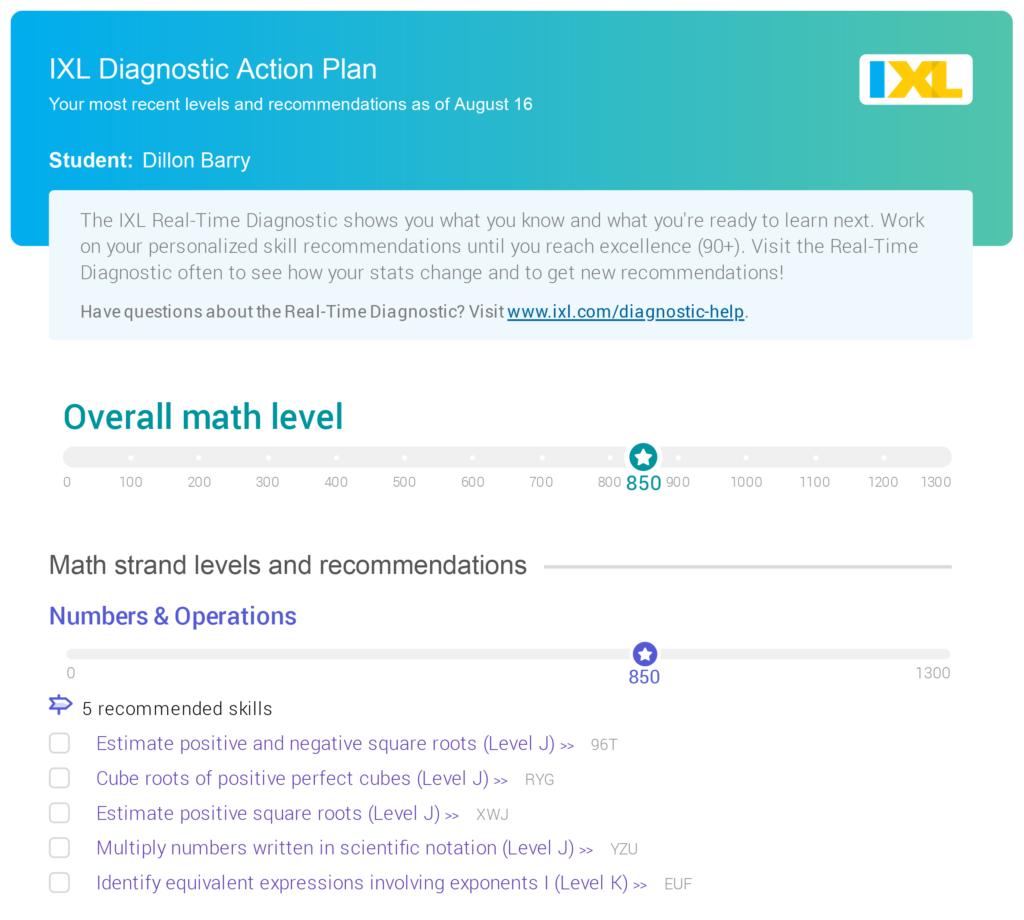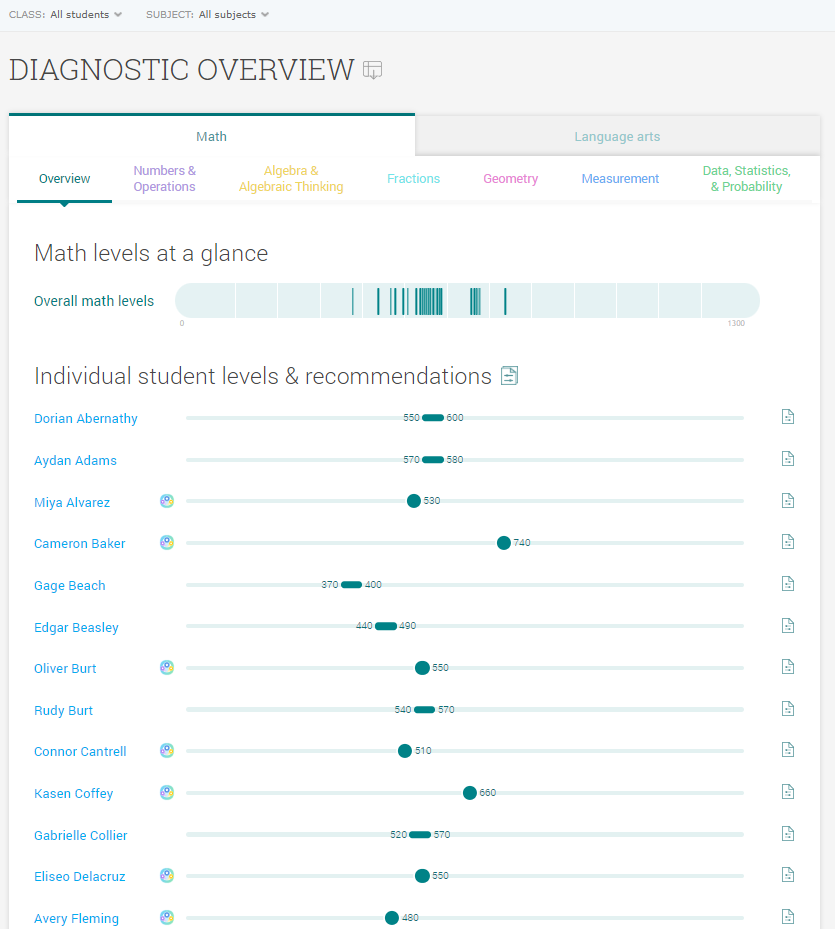Natasha Thomas is an IXL Professional Learning Specialist with over five years of experience as a special education teacher and curriculum developer.
As with any other transition, moving from middle to high school is a time of growth and adjustment. To help your learners feel supported through this important (and sometimes daunting!) change, IXL has all the tools you need!
If you’re one of the lucky ones, your schools work collaboratively to ensure student transition is as informed and as smooth as possible for all parties.
But this isn’t always feasible, and sometimes there is limited communication between students’ schools. In these cases, it can be difficult to gauge where students are upon leaving middle school and how to best support them in high school.
Regardless of your circumstances, IXL can help strengthen your understanding of each student’s current knowledge levels, and the best next steps to help them grow. Here are some IXL tools and tips you can use to ensure students are supported as they enter high school.
Assess student knowledge with the Real-Time Diagnostic
IXL’s assessment suite gives you all the information you need to make the best decisions for your students throughout their transition period. Whether you’re a middle school teacher collecting final assessment data to pass on, or a high school teacher that wants a baseline for each new student, IXL’s Real-Time Diagnostic will give you valuable and actionable data whenever you need it.
To understand how you can best provide for the student, you need to know what their current levels are. To begin, you should instruct your students to enter the Diagnostic arena, under the Assessment tab. Here, students will answer adaptive questions until they are notified that the diagnostic is complete. The diagnostic will pinpoint the student’s grade level proficiency across both math and ELA in as little as 45 minutes per subject.
Tip: Share this video with your students to help them get started with the diagnostic!
When students complete the diagnostic, each student (and you!) will get actionable next steps in the form of IXL skill recommendations. These are truly personalized recommendations based on each student’s individual needs within their Diagnostic Action Plan.

Following the assessment, you should use the Diagnostic Overview report in the Analytics tab to see where all of your students stand. From here, you can also download their personalized action plans and take note of students who still need to complete the assessment. You can also get an overview of your students’ levels across your whole class.

The Strand Analysis report will also help you group students for small group work based on those that have similar working levels. This report is great for determining what to cover with these students, as it also provides skills to work on that will be beneficial to all in the group. It lends itself to intervention grouping, and gives you an insight into appropriate working groups within your class.
Get benchmark data with the Diagnostic Snapshot
If your school is keen to monitor progress at fixed points in the year, your IXL administrator can set up a diagnostic in Snapshot mode. The IXL Diagnostic Snapshot captures student knowledge levels within a set time frame.
If students have been assigned to a Snapshot by your administrator, students will be directed to the Diagnostic arena upon signing in to IXL and should complete the assessment before the due date. Once the Snapshot window closes, teachers can access those data points throughout the year in the Analytics tab. This would be a great tool to monitor your new starters and track their growth as they move through their first year of high school.
Establish a routine
No matter how you are using IXL’s assessments, you should set your students up for success by establishing learning routines. Routine is paramount to ensuring students feel supported in new environments, and IXL can be easily incorporated into any routine or schedule.
Once students have pinpointed their diagnostic levels, you can designate one day a week when they step into the Diagnostic arena to keep their levels up to date. If students spend at least 10 minutes per week answering questions in the Diagnostic arena, you’ll have reliable assessment data at all times!
You could also assign a time when they focus on their action plans and recommendations to close their knowledge gaps. Establishing these predictable working times will help students feel secure in their new school and establish IXL as a part of their learning routine.
Quickly check for understanding with IXL Quizzes
IXL Quizzes are a versatile tool that teachers can use to round off a unit, check for understanding of topics, or use for review! They are excellent for preparing students for high school exam periods and the traditional testing model.
Head to the Quizzes tab under the My IXL tab to create, review, and manage your quizzes.

Teachers can leverage IXL’s comprehensive library of skills across all subjects to create a quiz. You can also customize the number of questions and the difficulty level of each question, so that you can create a quiz that is appropriate for your learners.
After a quiz is completed, you also have access to reports that give you an overview of how your students performed. Students can also view their quiz report which allows them to monitor their own practice, and encourages independence and reflection, which are valuable skills in high school!
Use IXL’s classroom tools to build rapport
Students in new classes often feel nervous about developing new friendships and working with other students. To motivate students and build rapport with your class, try out IXL Leaderboards and Group Jams! They can be accessed under Engagement tools within the My IXL tab.
IXL Leaderboards are customizable competitions that allow students to compete against each other based on criteria that you choose, including time spent on IXL, amount of skills mastered, skills practiced, and more. Both students and teachers can see the Leaderboard update in real time. It’s a great way to encourage friendly competition and establish fun, purposeful learning.
And to create a fun and collaborative learning environment, IXL Group Jams allow you to focus on the same IXL question as a class. You can use Group Jams to introduce new topics and check for understanding of skills, while engaging your students in meaningful conversation and helping to develop relationships.
At IXL, we want to ensure you have all the information you need to give students the best start in high school. Alongside the valuable student data that IXL provides, IXL’s classroom tools can help you and your students navigate this transition with ease.
Learn more about how you can use IXL in your high school math and high school ELA classrooms!
